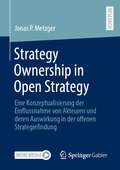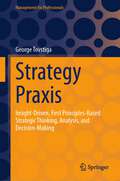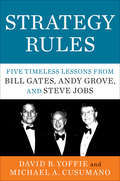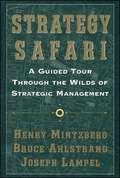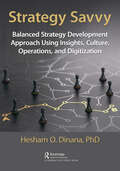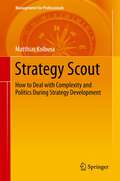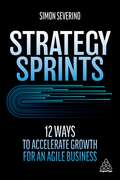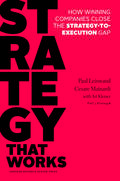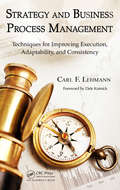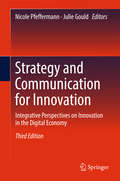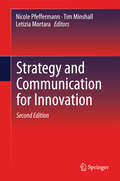- Table View
- List View
Strategy Ownership in Open Strategy: Eine Konzeptualisierung der Einflussnahme von Akteuren und deren Auswirkung in der offenen Strategiefindung
by Jonas Philippe MetzgerOpen Strategy beschreibt die Öffnung strategischer Prozesse in Unternehmen, wodurch Mitarbeiter und externe Akteure durch Inklusion in die Strategiefindung und durch die Transparenz strategischer Prozesse und Entscheidungen in die Strategiefindung einbezogen und informiert werden. Im Zuge des Einbeziehens haben diese Mitarbeiter und externen Akteure die Möglichkeit strategische Prozesse, unabhängig ihrer formellen Entscheidungsbefugnis, zu beeinflussen. Sofern dieser Einfluss in der Strategieformulierung und in der Strategieumsetzung identifizierbar ist, lässt sich Strategy Ownership bei Akteuren identifizieren. Strategy Ownership bietet hierbei die Möglichkeit Auswirkungen auf Mitarbeiter und externe Akteure im Rahmen der Strategiefindung und Umsetzung zu erklären und kausal zu begründen. Die vorliegende Untersuchung befasst sich mit der Fragestellung, wie strategische Entscheidungen in Open Strategy beeinflusst werden, wie Strategy Ownership in Open Strategy als theoretisch-konzeptioneller Bezugsrahmen im Open-Strategy-Kontext dargelegt werden kann und welche Implikationen sich durch das Konzept von Strategy Ownership ergeben.
Strategy Praxis: Insight-Driven, First Principles-Based Strategic Thinking, Analysis, and Decision-Making (Management for Professionals)
by George TovstigaThis book introduces a different approach to thinking about and engaging with strategy in the practice field. The insight-driven, first principles-based approach to strategising and strategic problem-solving developed in this book provides a conceptually rigorous yet pragmatic approach to strategising, and as such the book addresses deficiencies of the current theory-practice gap in the strategy field. In particular, the author introduces and develops a conceptually rigorous approach to the crucial transition stage from strategic analysis to strategic option formation in the strategy process. The book introduces several new concepts such as the firm's unique competing space and its strategic boundaries, the strategic thinking algorithm, and shows how these, when integrated with existing approaches and first-principles thinking, significantly enhance the coherence and effectiveness of strategic problem-solving in practice. Additionally, the book includes supplementary enhancing features throughout the chapters in the form of Praxis Reflections, Praxis Perspectives, and Praxis Cases that tie the concepts and methods presented to real-world strategy practice. This book will appeal not only to strategy practitioners, but also academic researchers and graduate-level students of strategic management.
Strategy Reading: Competing Globally
by Juan AlcacerThis Reading distills, synthesizes, and builds on insights from 5 academic domains that inform the topic of global competition: economics, international business, global strategy, business strategy, and corporate strategy. It identifies the challenges of competing internationally as well as the need for firms that do so to develop a global strategy. It also introduces the DDD framework (deployment, development, and deepening). The Reading then identifies the many factors that firms need to consider while developing and implementing a global strategy, such as activities, location, and timing. Together, these insights illustrate how competing globally differs from doing business in a single country and suggest frameworks that provide options for global value creation and value capture.
Strategy Reading: Competing Globally
by Juan AlcacerThis Reading distills, synthesizes, and builds on insights from 5 academic domains that inform the topic of global competition: economics, international business, global strategy, business strategy, and corporate strategy. It identifies the challenges of competing internationally as well as the need for firms that do so to develop a global strategy. It also introduces the DDD framework (deployment, development, and deepening). The Reading then identifies the many factors that firms need to consider while developing and implementing a global strategy, such as activities, location, and timing. Together, these insights illustrate how competing globally differs from doing business in a single country and suggest frameworks that provide options for global value creation and value capture.
Strategy Reading: Competitive Advantage
by Pankaj Ghemawat Jan W. Rivkin"Competitive Advantage" introduces core concepts in competitive advantage including value creation and distribution, added value, and willingness to pay and supplier opportunity cost. The Reading explores how a firm's unique activities directly relate to establishing competitive advantage. Students also learn how to analyze a firm's value proposition.
Strategy Reading: Competitive and Cooperative Dynamics
by Ramon Casadesus-MasanellThis Reading examines the competitive and cooperative interactions and interdependencies among firms in a competitive game, particularly in regard to how these firms attempt to create and capture value. It also provides a framework for understanding, predicting, and influencing the actions and reactions of other firms, and it considers how the perspectives and incentives of other firms can influence the nature of the game being played. This discussion provides the foundation for an introduction to game theory, which provides a rigorous way to analyze economic payoffs for players under various scenarios.
Strategy Reading: Competitive and Cooperative Dynamics
by Ramon Casadesus-MasanellThis Reading examines the competitive and cooperative interactions and interdependencies among firms in a competitive game, particularly in regard to how these firms attempt to create and capture value. It also provides a framework for understanding, predicting, and influencing the actions and reactions of other firms, and it considers how the perspectives and incentives of other firms can influence the nature of the game being played. This discussion provides the foundation for an introduction to game theory, which provides a rigorous way to analyze economic payoffs for players under various scenarios.
Strategy Reading: Executing Strategy
by J. Bruce Harreld"Executing Strategy" introduces students to the principles of effective strategy implementation. The Reading discusses key frameworks and emphasizes the interdependence of strategy development and execution in achieving and sustaining superior competitive performance.
Strategy Reading: Industry Analysis
by Ramon Casadesus-Masanell"Industry Analysis" is intended to familiarize students and executives with the core concepts in industry analysis. Students learn why the Porter forces framework is a valuable tool for understanding industry structure and how to perform one. This Reading will also address criticisms and limitations of the framework.
Strategy Reading: Introduction to Strategy
by Ramon Casadesus-Masanell"Introduction to Strategy" provides a comprehensive overview of the strategy discipline and introduces the building blocks of strategy by providing overviews of fundamental conceptual frameworks. Students will learn how firms decide where to compete by exploring the business landscape and the structural forces that shape competition. This Reading will also present alternative perspectives on strategy.
Strategy Reading: Introduction to Strategy
by Ramon Casadesus-Masanell"Introduction to Strategy" provides a comprehensive overview of the strategy discipline and introduces the building blocks of strategy by providing overviews of fundamental conceptual frameworks. Students will learn how firms decide where to compete by exploring the business landscape and the structural forces that shape competition. This Reading will also present alternative perspectives on strategy.
Strategy Reading: Setting Aspirations-Mission, Vision and Values
by Ramon Casadesus-Masanell"Setting Aspirations-Mission, Vision, and Values" introduces students to the concepts of organizational aspirations and the link to strategy. The Reading presents a framework for analyzing aspirations, discusses the differences between mission and vision, and uses industry examples to explore how mission and vision form a firm's strategy. It also addresses general misconceptions about organizational aspirations.
Strategy Reading: Sustaining Competitive Advantage
by Felix Oberholzer-GeeThis Reading examines the challenge of achieving sustained, superior profitability. It begins by considering some trends in financial returns that raise the question of whether sustained profitability is feasible. The Reading then explores seven mechanisms that can lead to extraordinary long-term performance, including switching costs, network effects, and learning. Finally, the author considers forces outside the market that can undermine superstar firms. Overall, the author argues that a long-lasting advantage is difficult, but not impossible, to achieve.
Strategy Reading: Technology Strategy
by Pai-Ling YinThis Reading examines how firms can use new technology to compete successfully. It starts by distinguishing how technology strategy is different from conventional competitive strategy. The Reading then describes how technology leaders can develop strategies to manage technology risks, identify market needs, commercialize new technologies, and compete successfully in a market. The author also identifies various factors that determine whether it is better for a firm to lead or follow when introducing a new technology to a market. Such factors include whether a new technology affects only current offerings in an existing industry, or whether it creates an entirely new offering for a new industry. The Reading then considers how a business can position itself to exploit the next new technology. A Supplemental Reading section explains the importance of platform technologies and the strategies that can help a firm succeed in platform competition.
Strategy Rules
by David B. Yoffie Michael A. CusumanoBetween 1968 and 1976, Bill Gates, Andy Grove, and Steve Jobs launched three companies that would define the world of high technology, create more than a trillion dollars in value, and transform our lives. How did they realize these incredible achievements? Strategy Rules examines these three individuals collectively for the first time--their successes and failures, comonalities and differences--revealing the business strategies and practices they pioneered while building their firms.Eminent business professors David Yoffie and Michael Cusumano have studied these three leaders and their companies for nearly thirty years, while teaching business strategy, innovation, and entrepreneurship at Harvard Business School and the MIT Sloan School of Management. In this enlightening guide, they show how Gates, Grove, and Jobs became masters of strategy. As CEOs, each approached strategy and execution in remarkably similar ways--yet markedly differently from their erstwhile competitors--keeping their focus on five rules: Look Forward, Reason Back: They determined where they want their companies to be in the future and could "reason back" to identify the moves that would take them there. Make Big Bets, Without Betting the Company: All three men made enormous strategic bets but rarely took gambles that put the financial viability of their companies at undue risk. Build Platforms and Ecosystems: Technology leaders have to create industry platforms that enable other firms to create complementary products and services that make the platforms increasingly valuable. Exploit Leverage and Power: Gates, Grove, and Jobs often turned opponents' strengths into weaknesses and used enormous resources (once they had them) to dominate competitors. Shape the Company around Your Personal Anchor: From Gates' understanding of software to Grove's devotion to process discipline and Jobs' obsession with design, all three built their companies around their personal strengths while compensating for their weaknesses.Strategy Rules brings together the best practices in strategic management and high-tech entrepreneurship, providing unique insights for start-up executives as well as the heads of modern multinationals.
Strategy Safari: A Guided Tour Through the Wilds of Strategic Management
by Carla BolteStrategy making is considered the high point of managerial activity. But bombarded by fads and fixes, most managers have been groping blindly to get their arms around the proverbial elephant. Now Henry Mintzberg, author of the award-winning The Rise and Fall of Strategic Planning,has teamed up with Bruce Ahlstrand and Joseph Lampel to create a powerful antidote: a comprehensive and illuminating -- as well as colorful -- tour through the fields of strategic management. Mintzberg, Ahlstrand, and Lampel have shaped each of ten different approaches into a coherent school of strategy formation. In the process, the authors clarify the enormous amount of confusion that exists. The result is a tour de force: a brilliant, penetrating primer on business strategy that is, at the same time, immensely readable and fun. The authors provide a thorough critique of the contributions and limitations of each school -- from the design, planning, positioning, entrepreneurial, and cognitive schools to the learning, power, cultural, environmental, and configurational schools -- culminating in how they might combine to reveal that elephant. Unique, insightful, and essential, Strategy Safari is the indispensable guide for the creative manager.
Strategy Savvy: Balanced Strategy Development Approach Using Insights, Culture, Operations, and Digitization
by Hesham O. DinanaWith the COVID-19 pandemic, many business leaders question the need for strategy and the value of strategic planning and management in today’s environment. This book will demonstrate that our approach to strategy development and implementation needs to change to be able to help organizations change. The proposed new approach in this book can provide insights and perspectives to keep strategy relevant by "Putting Strategy in Action" through developing a "Making the Future Happen Today" way of thinking and living. Many strategy books focus on the perspective of large multinational corporations that have the capacity and capabilities to develop and implement a strategy using very structured methodologies and tools. This book will add a new dimension by focusing on the use of Strategy-as-Practice (SaP), intuition, and serendipity as important complements that can be used by large corporations as well as small- and medium-sized enterprises (SMEs) and entrepreneurs to develop and implement winning strategies. This is an important dimension to support the strategic decision-making process that is frequently undermined in traditional strategic planning and management-focused books. The author theorizes that developing into a Strategy Savvy professional is about embracing two of the most important concepts in strategy development—Proactivity and Sustainability. This book addresses the opportunities and threats presented by VUCA (Volatility, Uncertainty, Complexity, and Ambiguity) and how we can capitalize on those opportunities to create unprecedented growth opportunities in Society 5.0 that is shaping new economies, such as the Digital Economy, the Experience Economy, the Sharing Economy, the GIG Economy, the Purpose Economy and the Circular Economy. The author also proposes a new approach to strategy development and implementation that mixes formal planning with practice and intuition that is helped by serendipity. He presents a strategy that is driven by four propellers—insights, culture, operations, and digitization—to ensure arrival at a better future.
Strategy Scorecards in Nonprofit, Government, and Health Care Organizations
by Robert S. Kaplan David P. NortonGovernment and nonprofit organizations can be strategic and build competitive advantage in ways other than pure operational excellence. But it takes vision and leadership to move beyond existing processes to a strategy that highlights which processes and activities are the most important to implement. This chapter provides examples of how the Balanced Scorecard has been applied in government, nonprofit, and health care organizations, with effective delivery of services to customers as the primary focus.
Strategy Scout
by Matthias KolbusaThere is a much better chance to politically establish a strategy in your company if strategy development is already tactically thought-out and all involved persons are included in an intelligent manner. This book demonstrates how to shape this process to ensure that a sustainable strategy is generated that ensures economic stability, uniquely positions the company and can readily be implemented. After all, strategy for its own sake is worthless - what counts is implementation and results. The centre stage of strategy process is taken by the intelligent use and combination of methodological tools. Numerous case studies from enterprises and medium-sized businesses illustrate strategy work in a vivid and clear manner.
Strategy Sprints: 12 Ways to Accelerate Growth for an Agile Business
by Simon SeverinoYou can grow your revenue and scale your business without sacrificing your whole personal life. It's all about working smarter, not longer. Strategy Sprints is the blueprint that you need to increase your effectiveness, grow your revenue and secure business resilience. Using the "Sprints" method, agile expert Simon Severino shows you how to transform your business with 12 assignments or "sprints" that will make you more impactful as a business leader, grow your revenue and make your strategy execution rock. Through these tried and tested exercises, businesses blow the competition out of the water. Strategy Sprints will teach you to identify the bottlenecks that are weighing your business down, turn you and anyone in your team into a sales superstar and streamline processes so you spend time where it matters. The outcomes you'll master include: - developing a compelling vision- mapping out where you can make the most money- increasing your conversion rates to salesWith plenty of practical tools and templates that work, learn how Strategy Sprints can transform your business.
Strategy That Works: How Winning Companies Close the Strategy-to-Execution Gap
by Paul Leinwand Cesare R. MainardiHow to close the gap between strategy and executionTwo-thirds of executives say their organizations don't have the capabilities to support their strategy. In Strategy That Works, Paul Leinwand and Cesare Mainardi explain why. They identify conventional business practices that unintentionally create a gap between strategy and execution. And they show how some of the best companies in the world consistently leap ahead of their competitors. Based on new research, the authors reveal five practices for connecting strategy and execution used by highly successful enterprises such as IKEA, Natura, Danaher, Haier, and Lego. These companies: Commit to what they do best instead of chasing multiple opportunities Build their own unique winning capabilities instead of copying others Put their culture to work instead of struggling to change it Invest where it matters instead of going lean across the board Shape the future instead of reacting to itPacked with tools you can use for building these five practices into your organization and supported by in-depth profiles of companies that are known for making their strategy work, this is your guide for reconnecting strategy to execution.
Strategy Under Uncertainty
by Patrick Viguerie Hugh Courtney Jane KirklandWhat makes for a good strategy in highly uncertain business environments? How do executives choose a clear strategic direction when no amount of sophisticated analysis will allow them to predict the future? The authors, consultants at McKinsey & Co., outline a new approach for dealing with the high levels of uncertainty that regularly confront managers today. This article explains how to make crucial distinctions among the levels of uncertainty managers face, and then how to choose a strategic posture appropriate for that level. This strategy framework helps managers to tailor a portfolio of actions--comprising big bets, options, and no-regrets moves--to the uncertainty at hand. An important and timely addition to the strategy arsenal, this article offers a discipline for thinking rigorously and systematically about uncertainty.
Strategy and Business Process Management: Techniques for Improving Execution, Adaptability, and Consistency
by Carl F. LehmannThis book prepares readers to master an IT and managerial discipline quickly gaining momentum in organizations of all sizes - Business Process Management (BPM). It describes how BPM treats processes as a portfolio of strategic assets that create and deliver customer and shareholder value and adapt, when necessary, enabling competitive advantage thr
Strategy and Communication for Innovation
by Nicole Pfeffermann Julie GouldThis contributed volume presents a state-of-the-art compendium for startups and corporations, focusing on corporate ventures. The book is based on the volume "Strategy and Communication for Innovation" and includes up-to-date discussions which help to better understand strategy and communication from a startup perspective. Each chapter offers a starting point for the exchange of ideas, key lessons and new insights from entrepreneurial perspectives such as e-ventures, corporate ventures and traditional ventures. Readers with an interest in innovation management will benefit from this book.
Strategy and Communication for Innovation
by Nicole Pfeffermann Tim Minshall Letizia MortaraThe innovation economy sets new standards for global business and requires efficient innovation management to plan, execute and evaluate innovation activities, establish innovation capability and coordinate resources and capacities for innovation on an intra- and inter-organizational level. Communication has become a critical factor underpinning successful innovation. As a new communication field, innovation communication facilitates the successful launches of new products and services, the establishment of stakeholder relationships, and the strengthening of corporate reputation in the long-run. Consequently, firms today need to develop a strong portfolio of communication tools as an integral part of their strategic innovation management activities. This new edition mainly concentrates on emerging approaches and methods for integrating communication as part of strategic innovation management. A key theme is the provision of an integrated perspective to bridge the gap between innovation management and communication management at both strategic and operational levels. This book makes an important contribution to this evolving academic domain by providing multiple perspectives on the latest research on innovation communication and strategic open innovation. It also provides guidance for managers seeking to understand the diverse ways by which they can leverage communication to support successful innovation.
